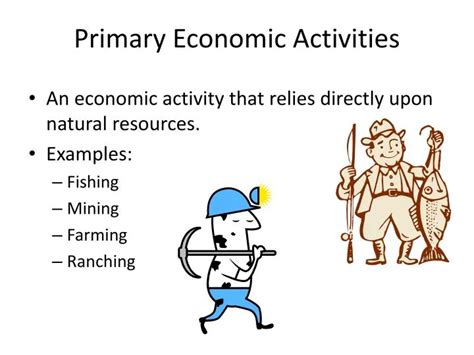Primary economic activities form the cornerstone of human existence. They involve the direct extraction or harvesting of natural resources from the environment, providing the essential materials and sustenance upon which societies thrive. These activities encompass a wide range of practices, from agriculture and mining to hunting and fishing.

Agriculture: The Backbone of Civilization
Agriculture, the cultivation of crops and livestock, is the most fundamental primary economic activity. For millennia, humans have domesticated plants and animals to ensure a reliable food supply. According to the United Nations Food and Agriculture Organization (FAO), agriculture accounts for approximately 26% of global gross domestic product (GDP) and employs over 40% of the world’s workforce.
Key Benefits of Agriculture
- Provides the primary source of food for the world’s population.
- Supports rural economies and livelihoods.
- Contributes to economic growth and development.
- Preserves natural ecosystems and biodiversity.
Challenges Facing Agriculture
- Climate change and environmental degradation.
- Increasing demand for food from a growing population.
- Competition for land and water resources.
- Market volatility and price fluctuations.
Mining: Extracting Earth’s Treasures
Mining involves the extraction of minerals, metals, and other valuable materials from the earth’s crust. These resources form the basis of industrial economies, providing raw materials for the production of goods and infrastructure. The mining industry generates approximately 5% of global GDP and employs millions of people worldwide.
Key Benefits of Mining
- Provides essential raw materials for industrial processes.
- Supports economic growth and development.
- Creates jobs and livelihoods in remote areas.
- Can generate significant tax revenue for governments.
Challenges Facing Mining
- Environmental impacts, particularly air and water pollution.
- Health and safety risks for miners.
- Social and economic disruptions in mining communities.
- Competition for mineral resources and price volatility.
Hunting and Fishing: Harvesting Nature’s Bounty
Hunting and fishing involve the pursuit and capture of wild animals and fish for food, fur, and other purposes. These activities have been practiced by humans since prehistoric times, providing sustenance and resources for populations across the globe.
Key Benefits of Hunting and Fishing
- Provides a source of food, particularly in rural and remote areas.
- Supports traditional cultural practices and livelihoods.
- Contributes to the conservation of wildlife and habitats.
- Can generate income through tourism and recreational activities.
Challenges Facing Hunting and Fishing
- Overfishing and depletion of fish stocks.
- Habitat loss and fragmentation.
- Conflicts between hunters and other stakeholders (e.g., conservationists, farmers).
- Hunting of endangered species and animal welfare concerns.
Conclusion
Primary economic activities remain essential to the well-being of human societies. From the cultivation of crops to the extraction of minerals and the harvesting of wildlife, these activities provide the very foundation upon which we build our civilizations.
As the world faces increasing population growth, environmental challenges, and economic disparities, it is crucial to sustainably manage our primary resources. By embracing innovative practices, mitigating environmental impacts, and ensuring equitable access to resources, we can harness the power of primary economic activities to create a more prosperous and sustainable future for all.
Tables
Table 1: Global Agricultural Production
| Crop | Production (2021) |
|---|---|
| Wheat | 777 million tons |
| Rice | 498 million tons |
| Corn | 1.2 billion tons |
| Soybeans | 380 million tons |
Table 2: Major Mining Commodities
| Mineral | Production (2020) |
|---|---|
| Iron ore | 2.2 billion tons |
| Coal | 8.1 billion tons |
| Copper | 21 million tons |
| Gold | 3,531 tons |
Table 3: Global Fish Production
| Type of Fish | Production (2021) |
|---|---|
| Wild-caught fish | 96.4 million tons |
| Aquaculture fish | 126.5 million tons |
Table 4: Primary Economic Activity Employment
| Activity | Employment (2019) |
|---|---|
| Agriculture | 1.3 billion |
| Mining | 105 million |
| Hunting and Fishing | 35 million |
